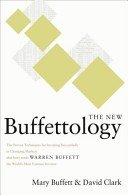New Buffettology: What Makes A Great Business?
The New Buffettology is the updated
version of Buffettology
Buffettology is one of the best books ever written on multi-billionaire investor Warren Buffett’s investment methodology. The New Buffettology is the updated version currently available.

Written by Buffett’s former daughter in law, this book is from someone who, thanks to personal and professional access to Warren Buffett himself, has been uniquely positioned to learn from the master investor.
The style is simple and down-to-earth, so the investment concepts are readily understandable. The content is well compartmentalised which makes New Buffettology a good bedtime read, and at the same time, it provides a practical introductory working manual for any aspiring early retirement investor.
New Buffettology explains in detail:
- how to identify excellent companies possessing superior economics, and it introduces:
- the concept of ’business perspective investing’ in which the price you pay for an investment determines your projected annual compound rate of return.
I think, these are arguably Warren’s two most powerful investment techniques, which can be learned by any self motivated early retirement investor.
Buffet's prime investment idea
Buffett's chief idea is to buy excellent businesses at a price that makes business sense. He (I and you!) is looking for investments that offer the highest possible predictable annual rate of return with the least amount of risk.
Unlike day traders and other short-term investors, Buffett is solely motivated by the long term so his approach to selecting and valuing businesses is different too. In its simplest form, Warren asks himself:
“How much can this business predictably earn and how does
the asking price compare with what I (Warren) think
the business is really worth”
The answers to these two questions are according to Warren the keys to achieving “Stockmarket Profits Beyond Imagination”.
Determine a business’ ‘intrinsic value’
Determining a business’ ‘intrinsic value’ is a key to deciphering Warren’s investment philosophy.
Warren’s principal valuation model is to compare:
- the price he is being asked to pay for the business today (the current share price), with
- what Warren calculates to be the future projected trading value (the future share price based on projected earnings per share growth and compounded return on equity), and
- the length of time required for that business to reach that projected value.
The annual compounding rate of return an investment is projected to earn is the value Warren uses to determine if it makes sense to invest or not compared to other non-equity investments.
When assessing a business for investment, Warren calculates the amount you have to pay to get the return you are looking for.
Pay above that amount and you are speculating that the business will do better than projected. Pay less and you will be getting a better return.
It sounds so simple and obvious . . . Doesn’t?
Perhaps...
But only when you have read and re-read New Buffettology several times and have actually tried out these calculations.
Personally, I am a great fan of Warren Buffet’s approach to investing.
When I read Buffettology for the first time it clarified my previously thinking on value investing and provided me with a number of new tools and approaches to consider potential interesting investment opportunities.
In addition, the book introduced me to the powerful concept of projected annual compound rates of return and assisted me in my thinking of what constitute a truly great business.
I fully subscribe to the mentioning on the strapline on the book jacket:
“No one who seriously wants to get richer by investing
can afford to miss this book”
and I wholeheartedly recommend any aspiring early retirement investor to consider purchasing it.
Order New Buffettology Here
For further reading on Warren Buffett
You may also want to consider The Buffett System, which I review HERE.
Return from this page to Investment Books
Return from this page to Home
If you came here via a search engine, you might want to go back to my main page on early retirement and investment






